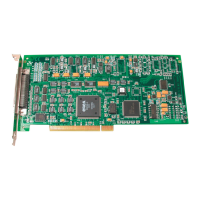Using Your Own Screw Terminal Panel
79
A
A
A
A
A
A
A
A
A
Analog Inputs
DT300 Series boards have three different types of analog input
configurations that you can use:
• Single-ended,
• Pseudo-differential, and
• Differential.
Single-Ended Inputs
With single-ended inputs, you have the maximum number of inputs
but have the worst-case noise immunity without external signal
conditioning.
The major problem with this configuration it that you need a
common ground between the external inputs and the data acquisition
board. Even with conditioning, consideration must be given to the
cable length and how the cable is routed. If the cable is over 3 feet,
you must consider the ringing and cross-talk in the cable. A typical
cable has 30 pF per foot of capacitance. If the source impedance is
1,000 Ω and the cable is 3 feet, then the cross talk based on the source
impedance is 1,000 Ω x (30 pF x 3 ft) = 90 ns.
This seems negligible, but when you consider that it requires nine
time constants to settle within 0.01%, the cross-talk becomes almost
10% of the time required to settle when switching channels at
100 kHz.
Coupling must also be considered when adjacent channels have
high-speed signals, especially if these signals are TTL-type with
high-speed edges.

